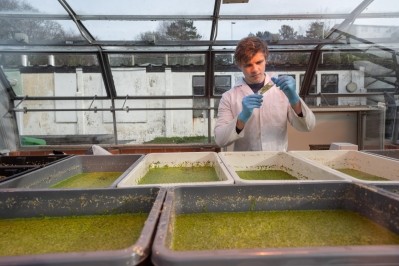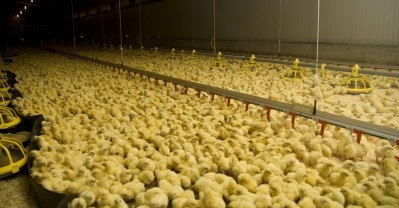Special Edition: Lowering the carbon footprint of feed
UK team shows novel proteins can reduce the environmental burden of EU poultry production
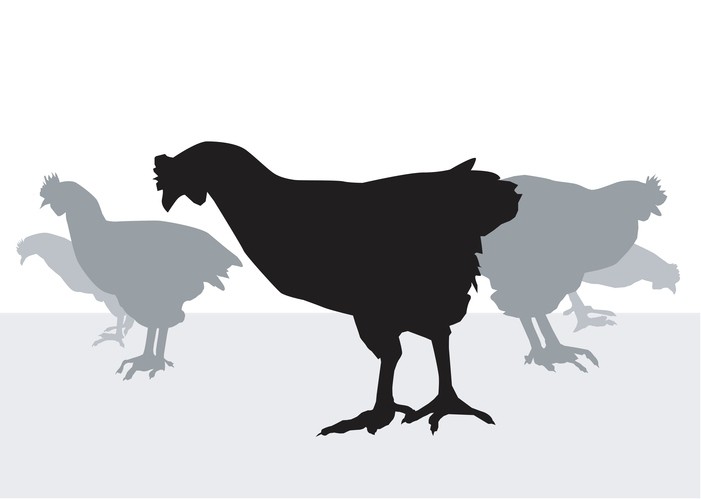
The authors, based at Newcastle University, evaluated the environmental implications of replacing soybeans with feed formulations based on microalgae, macroalgae, duckweed, yeast protein concentrate (YPC), bacterial protein meal (BPM), leaf protein concentrate (LPC) and insect meal for two chicken lines – a fast growing one and a slow one based on high welfare principles.
The parameters they used to compare the environmental impact potential of each potential diet formulation were greenhouse gas (GHG) emissions, agricultural land use (ALU) and the total nitrogen (N) and phosphorus (P) that would be excreted.
Price is a major market entry barrier that puts new candidate feeds under great pressure as they need to be able to compete against the ‘economy of scale’ that many of the mass-produced feeds have established over decades, found an EIP-AGRI report published in May this year.
“For every alternative diet formulated with a fixed inclusion of one novel ingredient, at least two burdens were reduced compared to the conventional diets,” the authors concluded.
No alternative diet formulation reduced all four environmental burdens simultaneously, when compared to the conventional diets though, they added.
The paper, which was partly funded by the EU Horizon 2020 programe, as part of the Feed-a-Gene project, was published in the June 2018 edition of the Journal of Cleaner Production.
The team said theirs is the first study to investigate the potential of several novel ingredients to reduce the total required soybeans in future chicken diets, by combining linear programming feed formulation and a LCA methodology with horizon scanning.
Lead author, Craig Tallentire, researcher, School of Natural and Environmental Sciences, Newcastle University, told FeedNavigator:
"I believe the take-home message is that novel ingredients show great potential for replacing soybeans as the principal protein component of monogastric diets. And the environmental impact reductions associated with the novel diets may be useful for mitigating the transition towards slower growing chicken production systems.
"There is, however, a lot more work that needs to be done to effectively upscale the production of each of the novel ingredients before they can become a realistic option for the future."
Background
The poultry industry collectively consumes the most soybeans of any livestock sector in Europe (van Gelder et al., 2008), and the EU is heavily reliant on protein sources, mainly, soybeans, from the Americas, leaving it exposed to the vagaries of trade, price volatility and ingredient scarcity.
“Furthermore, feed provision represents the poultry industry's biggest environmental hotspot (Leinonen et al., 2012; Tallentire et al., 2017), exacerbated by the inclusion of imported soybeans from South America where they are grown in vast monocultures on land obtained via deforestation (de Visser et al., 2014; Kebreab et al., 2016; Leinonen et al., 2012; van der Werf et al., 2009).”
In terms of existing substitutes for soybean products in European poultry diets, the team said fishmeal is limited and the use of processed animal proteins (PAP), for now, is banned, while growing soy in Europe is non-competitive with imports due to relatively low yields and long growing seasons (van Krimpen (2013).
As such, the European poultry industry is presented with the challenge of providing an adequate and more sustainable supply of protein to feed its broilers, noted the research group.
They thus decided to assess novel proteins selected on the basis of five criteria:
1) The ingredient could potentially serve as an alternative to imported soybeans in livestock diets. 2) The incorporation of the ingredient into chicken diets was not common practice already. 3) The maximum inclusion limit of the novel ingredient, its digestible amino acid profile and metabolizable energy content were avail-able in the literature. 4) Production in Europe is a realistic option for the future. 5) Enough data was available to compile an inventory of relevant energy and material inputs and environmental releases per novel ingredient.
Methodology
Using horizon scanning and a modelling approach, the nutritional requirements of two potential meat-producing chicken lines were simulated. The two chicken lines were a fast-growing line based on the apparent maximum feed efficiency that could be achieved through further artificial selection, and a reduced growth rate for high welfare line.
Diets were formulated to include the novel ingredients, while meeting the nutritional requirements of the birds.
The effects of diet composition on indicators of environmental burdens, associated with feed production for the poultry industry, were then assessed. Simapro software was used to conduct life cycle assessment (LCA) calculations.
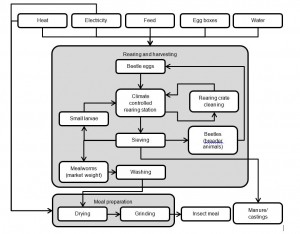
Results
The researchers found that microalgae, YPC, BPM, LPC and insect meal diets all had lower associated GHG emissions than the conventional diets, but incorporating macroalgae and duckweed into the diets resulted in greater GHG emissions than the conventional diets.
“Macroalgae and duckweed have low energy contents relative to conventional protein and energy sources, e.g. soybean meal and wheat respectively, hence the energy deficit caused by the incorporation of these ingredients was largely counteracted by the increased incorporation of oil and maize gluten meal which increased the GHG burden of the diets.”
Since the arable land in developed countries has declined in recent decades and this trend is expected to continue into the future, reducing the ALU burden of European livestock production is critical, they noted.
“Every diet that included novel ingredients formulated in this study had an overall lower ALU burden than the conventional diet corresponding to the requirements of each meat-producing chicken line. This is because the cultivation of the novel ingredients was intrinsically associated with low arable land requirements, especially the aquatic novel ingredients and BPM. LPC, YPC and insect meal all had a higher ALU burden [relative to the other novel ingredients analyzed] due to the requirement of arable land to produce the feedstock used in these system processes, but all these novel ingredients had a lower ALU burden than soybeans and their derivatives.”
The novel ingredients with the highest crude protein content and crude protein to amino acid ration, e.g. YPC resulted in the highest N in the excreta, the team found.
“Similarly, ingredients which had the highest total P content and had the lowest available P to total P ratio, resulted in the highest P in the excreta. Macroalgae was the novel ingredient with lowest total P content, whilst insect meal had the highest available P to total P ratio.”
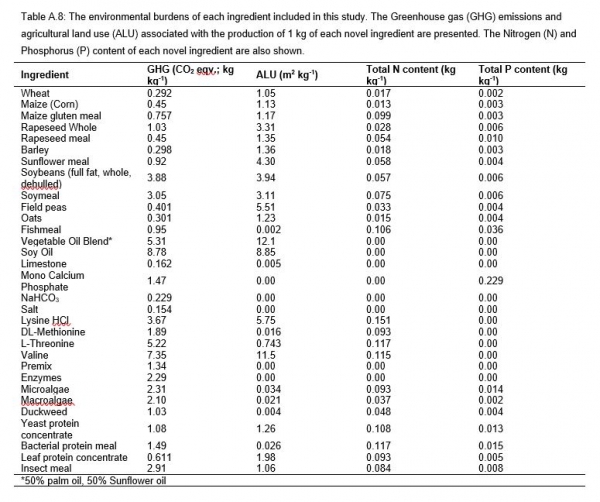
Slow growing birds
While the total environmental burdens of feeding the birds each diet were greater for the slower-growing line than they were for the fast-growing line, in some cases the incorporation of novel ingredients led to the slow-growing line having at least some environmental burdens that were lower than those of the fast-growing line fed on a conventional diet formulation, said the authors.
“Incorporating microalgae, BPM, LPC and insect meal all reduced at least two environmental burdens of the slow-growing birds, compared to fast-growers reared on the conventional diet.
“This shows that the environmental burdens of feed associated with transitioning towards a slow-growing, high welfare chicken production system can be partially mitigated through carefully considered nutritional and manure management.”
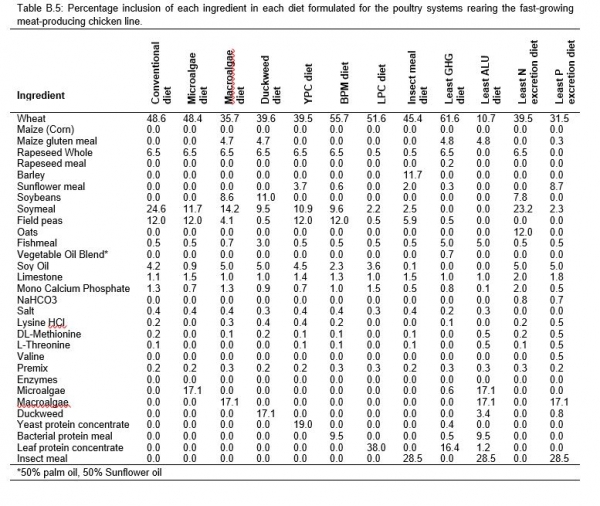
Ingredients 'still in their infancy'
The team noted that the technologies being developed to produce these novel ingredients are still in their infancy and that much work is required to viably upscale these system processes so that production is efficient and competitive with imported soybeans.
“Additional research is still required in the characterization of these ingredients and their effects on specific livestock before they can become viable feed alternatives.”
And in some cases, they said, legislation still prevents their use in Europe, as in the case of insect meal in poultry rations.
Source: Journal of Cleaner Production
Title: Can novel ingredients replace soybeans and reduce the environmental burdens of European livestock systems in the future?
Published online ahead of print: https://doi.org/10.1016/j.jclepro.2018.03.212
Authors: C.W. Tallentire et al
